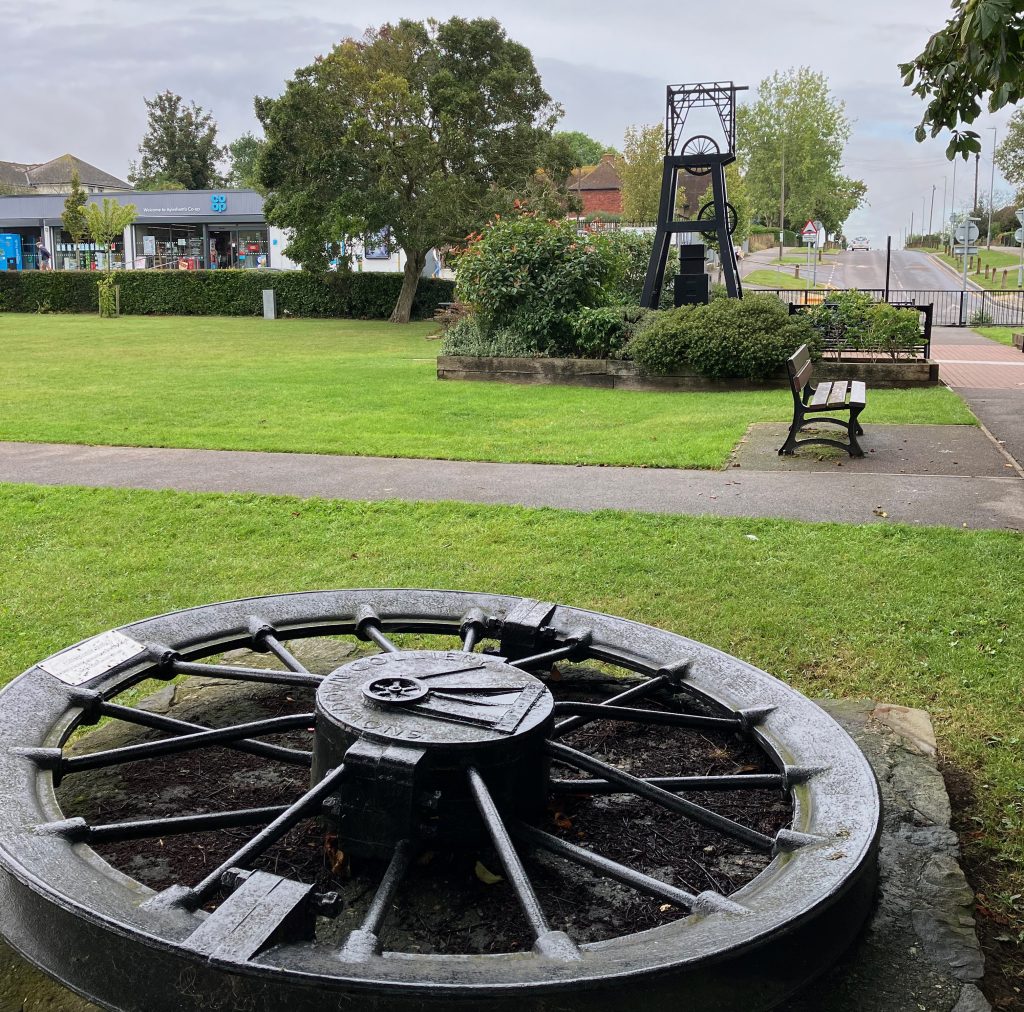There is evidence of human habitation around Aylesham dating back to the Bronze Age, but the current village is less than one hundred years old and owes its existence to just one thing – the discovery of coal under the Kent Downs.
The village was purpose-built to house miners working at the newly opened Snowdown Colliery in the 1920s. The new settlement attracted miners from across the north of England and south Wales who were struggling to find work at home. Many landlords in nearby Kent towns refused to accommodate these “dirty” migrants so Aylesham provided a welcome sanctuary.
Because of its relatively isolated location between Canterbury and Dover, Aylesham quickly coalesced into tightknit community with its own unique dialect that merged the diverse speech patterns of the new migrants, and brought in cultural traditions unheard of in rural Kent such as male voice choirs, brass bands and rugby, traditions that survive in Aylesham today.

Commemorating the coal industry in Aylesham’s main square.
Aylesham is also unique in its design. It was laid out by England’s foremost urban planner Patrick Abercrombie as a “garden village,” based on the principles of the garden city movement at the time. The village streets radiated out from a central square and resembled from above the outline of a pithead. The original plans envisioned a town of up to 30,000 inhabitants but the coal field never expanded sufficiently to accommodate so many miners and for decades Aylesham remained a relatively small community dependant on the Snowdown Colliery.
In the early 1980s, the National Coal Board, at the direction of newly elected prime minister Margaret Thatcher, targeted dozens of “uneconomic” mines, including Snowdown, for closure. The plans were put on hold after widespread opposition but when Thatcher was re-elected by a landslide in 1983, the leader of the National Union of Mineworkers, Arthur Scargill correctly perceived an existential threat to the industry and his union.
Battle lines were drawn, and few places were more determined to fight than the mine villages of Kent. Throughout the year-long strike that began in 1984, thousands of miners, most notably in Nottinghamshire, deserted the cause, but not one Aylesham miner ever crossed the picket line.
After their perhaps inevitable defeat, the miners went back to work in 1985 but Snowdown was losing £6 million a year and it was shut down for good in 1987, followed two years later by the last surviving Kent coalmine at Betteshanger.
The Betteshanger site has now been redeveloped into a country park and is home to the excellent Kent Mining Museum. But Snowdown remains untouched, apparently because the Plumtree family, which owns the land, has leased it to the coal board until 2040, and is happy just to collect the rent.

Snowdown colliery buildings abandoned for decades.
The abandoned colliery buildings are a relic of a vanished industry. Aylesham however has moved on, and has expanded significantly in the last ten years with the development of 1,200 homes in what is being marketed as a “new garden village” but, in reality, is just another dormitory town for people working in Canterbury, with limited local infrastructure to support it.
Even though memorials to the mining industry (and those that died working in it) are dotted across the village, and road names such as Pit Head Drive hint at the past, many of the new residents seemingly have no idea that Aylesham was once a mining village. For younger inhabitants, who may have never seen a lump of coal, the mining industry is ancient history.
In response, a group of former miners have established a mining heritage centre in the parish hall which has an invaluable collection of memorabilia, photographs, and documents chronicling the history of Snowdown. And they are not alone, the Aylesham Community Trust is a registered charity dedicated to bringing new life, arts, and culture to the village. It is housed in the old secondary school building, which was closed around the same time as the mines, and organizes a wide-range of activities for the local community, including the We are Aylesham festival last September.
One issue currently under discussion by the Parish Council is how to commemorate the 40th anniversary of the miners’ strike next year. There are those in the village who would prefer just to forget the whole thing; it was after all a painful defeat for the miners and their families, but I hope it does go ahead. The miners’ strike was one of the defining events of the 1980s, and its impact on the trade union movement is still being felt today. The strike may have been poorly led and rife with division but the struggle was justified, and the solidarity displayed at communities like Aylesham was truly inspirational. That spirit of solidarity at least deserves to be commemorated and rekindled for a new generation.